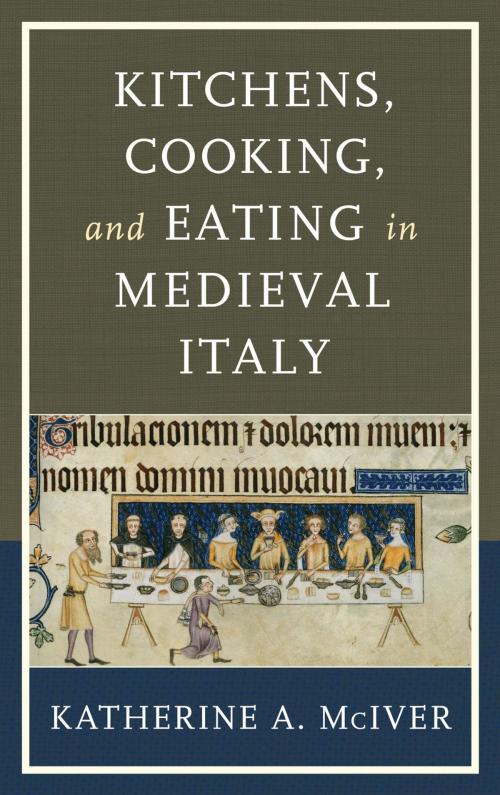Kitchens, Cooking, and Eating in Medieval Italy
Nonfiction, Food & Drink, Food Writing, Social & Cultural Studies, Social Science, Anthropology| Author: | Katherine A. McIver | ISBN: | 9781442248953 |
| Publisher: | Rowman & Littlefield Publishers | Publication: | October 16, 2017 |
| Imprint: | Rowman & Littlefield Publishers | Language: | English |
| Author: | Katherine A. McIver |
| ISBN: | 9781442248953 |
| Publisher: | Rowman & Littlefield Publishers |
| Publication: | October 16, 2017 |
| Imprint: | Rowman & Littlefield Publishers |
| Language: | English |
The modern twenty-first century kitchen has an array of time saving equipment for preparing a meal: a state of the art stove and refrigerator, a microwave oven, a food processor, a blender and a variety of topnotch pots, pans and utensils. We take so much for granted as we prepare the modern meal – not just in terms of equipment, but also the ingredients, without needing to worry about availability or seasonality. We cook with gas or electricity – at the turn of the switch we have instant heat. But it wasn’t always so. Just step back a few centuries to say the 1300s and we’d find quite a different kitchen, if there was one at all. We might only have a fireplace in the main living space of a small cottage. If we were lucky enough to have a kitchen, the majority of the cooking would be done over an open hearth, we’d build a fire of wood or coal and move a cauldron over the fire to prepare a stew or soup. A drink might be heated or kept warm in a long-handled saucepan, set on its own trivet beside the fire. Food could be fried in a pan, grilled on a gridiron, or turned on a spit. We might put together a small improvised oven for baking. Regulating the heat of the open flame was a demanding task. Cooking on an open hearth was an all-embracing way of life and most upscale kitchens had more than one fireplace with chimneys for ventilation. One fireplace was kept burning at a low, steady heat at all times for simmering or boiling water and the others used for grilling on a spit over glowing, radiant embers. This is quite a different situation than in our modern era – unless we were out camping and cooking over an open fire.
In this book Katherine McIver explores the medieval kitchen from its location and layout (like Francesco Datini of Prato two kitchens), to its equipment (the hearth, the fuels, vessels and implements) and how they were used, to who did the cooking (man or woman) and who helped. We’ll look at the variety of ingredients (spices, herbs, meats, fruits, vegetables), food preservation and production (salted fish, cured meats, cheese making) and look through recipes, cookbooks and gastronomic texts to complete the picture of cooking in the medieval kitchen. Along the way, she looks at illustrations like the miniatures from the Tacuinum Sanitatis (a medieval health handbook), as well as paintings and engravings, to give us an idea of the workings of a medieval kitchen including hearth cooking, the equipment used, how cheese was made, harvesting ingredients, among other things. She explores medieval cookbooks such works as Anonimo Veneziano, Libro per cuoco (fourtheenth century), Anonimo Toscano, Libro della cucina (fourteenth century), Anonimo Napoletano (end of thirteenth/early fourteenth century), Liber de coquina, Anonimo Medidonale, Due libri di cucina (fourteenth century), Magninus Mediolanensis (Maino de’ Maineri), Opusculum de saporibus (fourteenth century), Johannes Bockenheim, Il registro di cucina (fifteenth century), Maestro Martino’s Il Libro de arte coquinaria (fifteenth century) and Bartolomeo Sacchi, called Platina’s On Right Pleasure and Good Health (1470). This is the story of the medieval kitchen and its operation from the thirteenth-century until the late fifteenth-century.
The modern twenty-first century kitchen has an array of time saving equipment for preparing a meal: a state of the art stove and refrigerator, a microwave oven, a food processor, a blender and a variety of topnotch pots, pans and utensils. We take so much for granted as we prepare the modern meal – not just in terms of equipment, but also the ingredients, without needing to worry about availability or seasonality. We cook with gas or electricity – at the turn of the switch we have instant heat. But it wasn’t always so. Just step back a few centuries to say the 1300s and we’d find quite a different kitchen, if there was one at all. We might only have a fireplace in the main living space of a small cottage. If we were lucky enough to have a kitchen, the majority of the cooking would be done over an open hearth, we’d build a fire of wood or coal and move a cauldron over the fire to prepare a stew or soup. A drink might be heated or kept warm in a long-handled saucepan, set on its own trivet beside the fire. Food could be fried in a pan, grilled on a gridiron, or turned on a spit. We might put together a small improvised oven for baking. Regulating the heat of the open flame was a demanding task. Cooking on an open hearth was an all-embracing way of life and most upscale kitchens had more than one fireplace with chimneys for ventilation. One fireplace was kept burning at a low, steady heat at all times for simmering or boiling water and the others used for grilling on a spit over glowing, radiant embers. This is quite a different situation than in our modern era – unless we were out camping and cooking over an open fire.
In this book Katherine McIver explores the medieval kitchen from its location and layout (like Francesco Datini of Prato two kitchens), to its equipment (the hearth, the fuels, vessels and implements) and how they were used, to who did the cooking (man or woman) and who helped. We’ll look at the variety of ingredients (spices, herbs, meats, fruits, vegetables), food preservation and production (salted fish, cured meats, cheese making) and look through recipes, cookbooks and gastronomic texts to complete the picture of cooking in the medieval kitchen. Along the way, she looks at illustrations like the miniatures from the Tacuinum Sanitatis (a medieval health handbook), as well as paintings and engravings, to give us an idea of the workings of a medieval kitchen including hearth cooking, the equipment used, how cheese was made, harvesting ingredients, among other things. She explores medieval cookbooks such works as Anonimo Veneziano, Libro per cuoco (fourtheenth century), Anonimo Toscano, Libro della cucina (fourteenth century), Anonimo Napoletano (end of thirteenth/early fourteenth century), Liber de coquina, Anonimo Medidonale, Due libri di cucina (fourteenth century), Magninus Mediolanensis (Maino de’ Maineri), Opusculum de saporibus (fourteenth century), Johannes Bockenheim, Il registro di cucina (fifteenth century), Maestro Martino’s Il Libro de arte coquinaria (fifteenth century) and Bartolomeo Sacchi, called Platina’s On Right Pleasure and Good Health (1470). This is the story of the medieval kitchen and its operation from the thirteenth-century until the late fifteenth-century.















